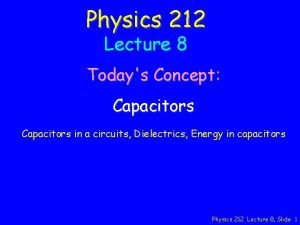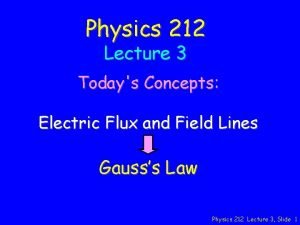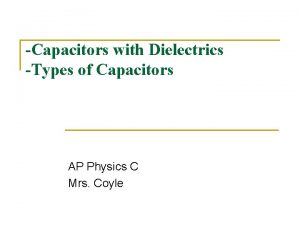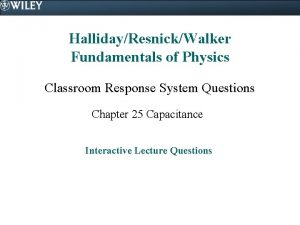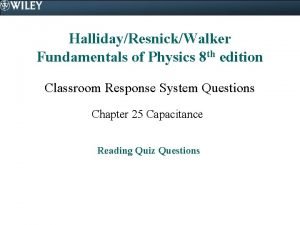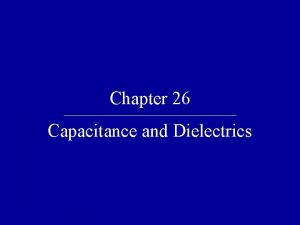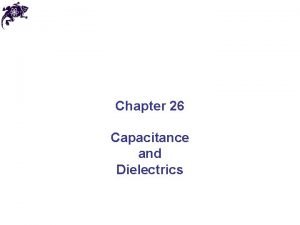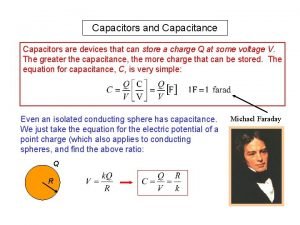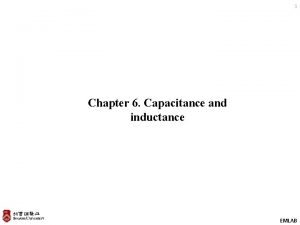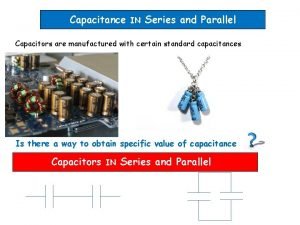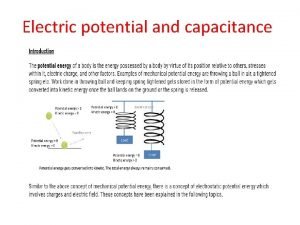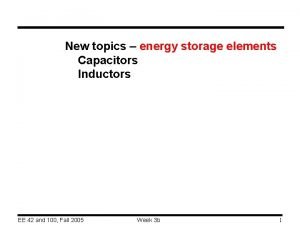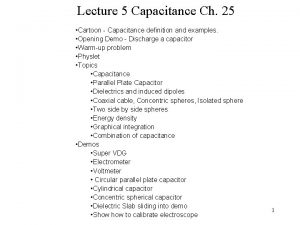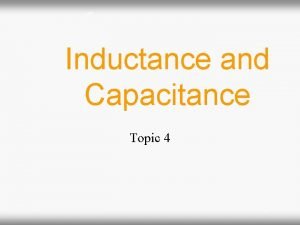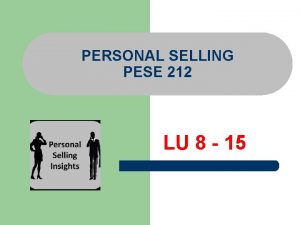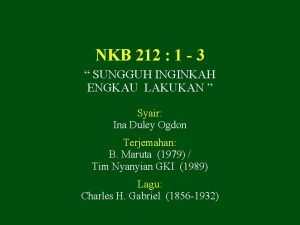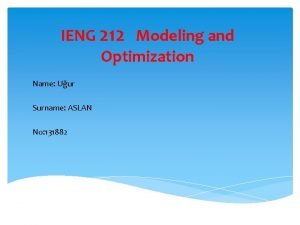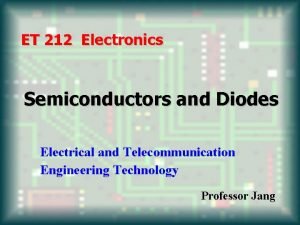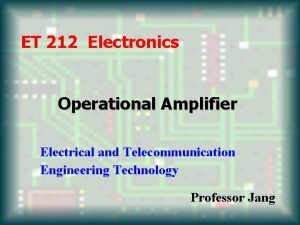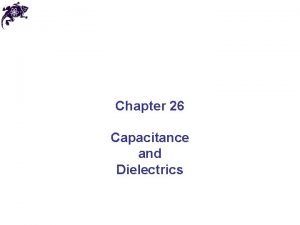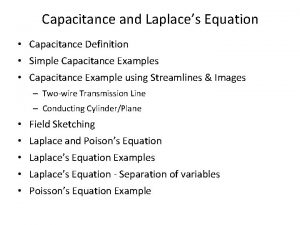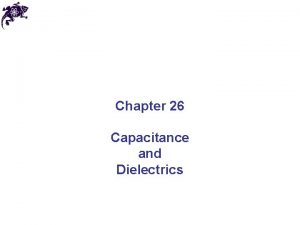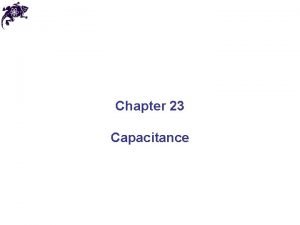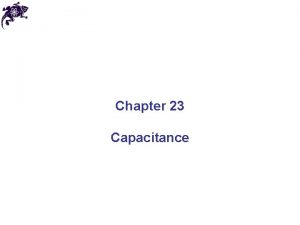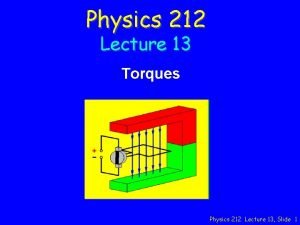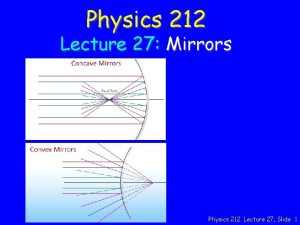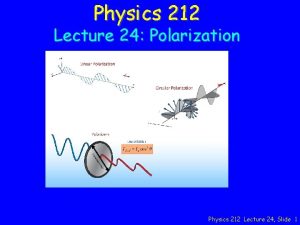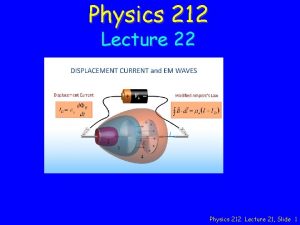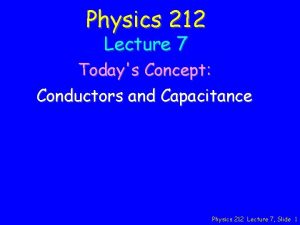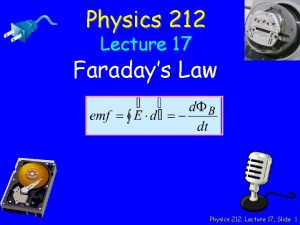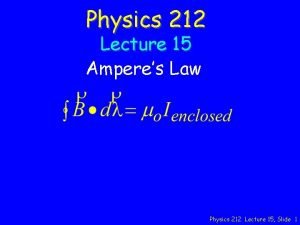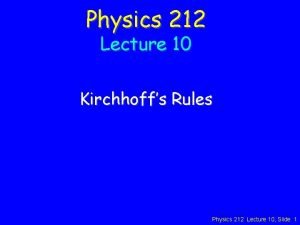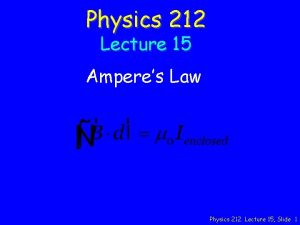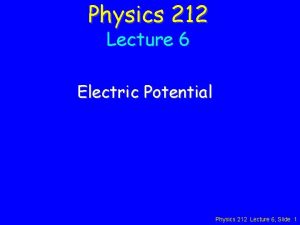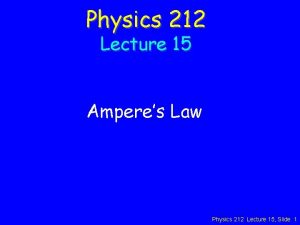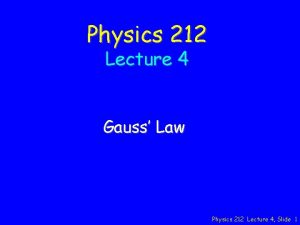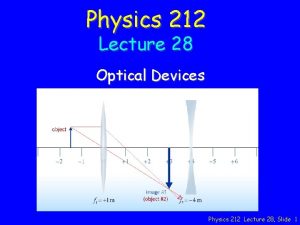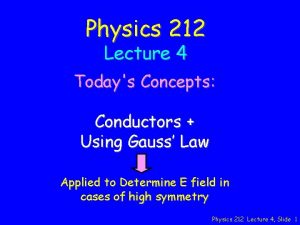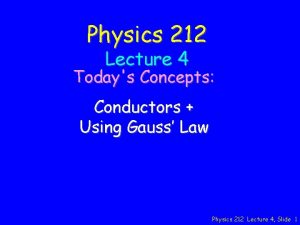Physics 212 Lecture 7 Conductors and Capacitance Physics






















- Slides: 22

Physics 212 Lecture 7 Conductors and Capacitance Physics 212 Lecture 7, Slide 1

Conductors The Main Points • • • Charges free to move E = 0 in a conductor Surface = Equipotential In fact, the entire conductor is an equipotential E perpendicular to surface E = / o Cavity inside a conductor: E = 0, unaffected by fields and charges outside. 5 Physics 212 Lecture 7, Slide 2

Checkpoint 1 a Two spherical conductors are separated by a large distance. They each carry the same positive charge Q. Conductor A has a larger radius than conductor B. Compare the potential at the surface of conductor A with the potential at the surface of conductor B. A. VA > VB B. VA = VB C. VA < VB 6 Physics 212 Lecture 7, Slide 3

Checkpoint 1 b The two conductors are now connected by a wire. How do the potentials at the conductor surfaces compare now? A. VA > VB B. VA = VB C. VA < VB 7 Physics 212 Lecture 7, Slide 4

Checkpoint 1 c What happens to the charge on conductor A after it is connected to conductor B by the wire? A. QA increases B. QA decreases C. QA doesn’t change 8 Physics 212 Lecture 7, Slide 5

Charging a Capacitor Q V C +Q -Q V C Q=VC Q This “Q” really means that the battery has moved charge Q from one plate to the other, so that one plate holds +Q and the other -Q. 8 Physics 212 Lecture 8, Slide 6

Capacitance is defined for any pair of spatially separated conductors Unit is the Farad How do we understand this definition ? • Consider two conductors, one with excess charge = +Q and the other with excess charge = -Q +Q d E V -Q • These charges create an electric field in the space between them • We can integrate the electric field between them to find the potential difference between the conductors. • This potential difference should be proportional to Q ! • The ratio of Q to the potential difference is the capacitance and only depends on the geometry of the conductors 9 Physics 212 Lecture 7, Slide 7

Parallel plate capacitance First determine E field produced by charged conductors: +Q y d x E -Q A = area of plate Second, integrate E to find the potential difference V As promised, V is proportional to Q. C determined by geometry ! 12 Physics 212 Lecture 7, Slide 8

Question +Q 0 Initial charge on capacitor = Q 0 d -Q 0 Insert uncharged conductor Charge on capacitor now = Q 1 +Q 1 d t -Q 1 How is Q 1 related to Q 0 ? ? A. Q 1 < Q 0 B. Q 1 = Q 0 C. Q 1 > Q 0 14 Plates not connected to anything CHARGE CANNOT CHANGE !! Physics 212 Lecture 7, Slide 9

Parallel Plate Capacitor Two parallel plates of equal area carry equal and opposite charge Q 0. The potential difference between the two plates is measured to be V 0. An uncharged conducting plate (the green thing in the picture below) is slipped into the space between the plates without touching either one. The charge on the plates is adjusted to a new value Q 1 such that the potential difference between the plates remains the same. Physics 212 Lecture 7, Slide 10

Where to Start? ? +Q 0 d t -Q 0 What is the total charge induced on the bottom surface of the conductor? A. B. C. D. E. 17 +Q 0 -Q 0 0 Positive but the magnitude unknown Negative but the magnitude unknown Physics 212 Lecture 7, Slide 11

WHY ? +Q 0 -Q 0 +Q 0 E E=0 E -Q 0 WHAT DO WE KNOW ? E must be = 0 in conductor ! Charges inside conductor move to cancel E field from top & bottom plates 19 Physics 212 Lecture 7, Slide 12

Calculate V Now calculate V as a function of distance from the bottom conductor +Q 0 y E d t y -E 0 d E=0 t V -Q 0 21 What is DV = V(d)? A) DV = E 0 d B) DV = E 0(d – t) C) DV = E 0(d + t) y The integral = area under the curve Physics 212 Lecture 7, Slide 13

Back to Checkpoint 2 a Two parallel plates of equal area carry equal and opposite charge Q 0. The potential difference between the two plates is measured to be V 0. An uncharged conducting plate (the green thing in the picture below) is slipped into the space between the plates without touching either one. The charge on the plates is adjusted to a new value Q 1 such that the potential difference between the plates remains the same. A) Q 1 < Qo B) Q 1 = Qo C) Q 1 > Qo Physics 212 Lecture 7, Slide 14

Checkpoint 2 b Two parallel plates of equal area carry equal and opposite charge Q 0. The potential difference between the two plates is measured to be V 0. An uncharged conducting plate (the green thing in the picture below) is slipped into the space between the plates without touching either one. The charge on the plates is adjusted to a new value Q 1 such that the potential difference between the plates remains the same. What happens to C 1 relative to C 0? A) C 1 > Co B) C 1 = Co C) C 1 < Co We store more charge, Q 1 = C 1 V 0 > Q 0 = C 0 V 0 for the same voltage difference. Same V: V 0 = E 0 d V 0 = E 1(d – t) C 0 = Q 0/E 0 d C 1 = Q 1/(E 1(d – t)) E = Q/ 0 A C 0 = 0 A/d C 1 = 0 A/(d – t) Physics 212 Lecture 7, Slide 15

Energy in Capacitors 31 Physics 212 Lecture 7, Slide 16

Calculation cross-section a 4 a 3 A capacitor is constructed from two conducting cylindrical shells of radii a 1, a 2, a 3, and a 4 and length L (L >> ai). a 2 a 1 What is the capacitance C of this device ? metal • Conceptual Analysis: But what is Q and what is V? • Important Point: C is a property of the object! (concentric cylinders) • Assume some Q (i. e. , +Q on one conductor and –Q on the other) • These charges create E field in region between conductors • This E field determines a potential difference V between the conductors • V should be proportional to Q; the ratio Q/V is the capacitance. 33 Physics 212 Lecture 7, Slide 17

Calculation cross-section +Q + + + -Q + + + a 2 a 1 + a 4 a 3 + metal + + A capacitor is constructed from two conducting cylindrical shells of radii a 1, a 2, a 3, and a 4 and length L (L >> ai). What is the capacitance C of this capacitor ? + + + metal Where is +Q on outer conductor located? (A) at r=a 4 (B) at r=a 3 (C) both surfaces (D) throughout shell Why? Gauss’ law: We know that E = 0 in conductor (between a 3 and a 4) +Q must be on inside surface (a 3), so that Qenclosed = + Q – Q = 0 Physics 212 Lecture 7, Slide 18

Calculation cross-section +Q + + - - - - + + - -Q - + + - - metal - + + + + a 2 a 1 + a 4 a 3 A capacitor is constructed from two conducting cylindrical shells of radii a 1, a 2, a 3, and a 4 and length L (L >> ai). What is the capacitance C of this capacitor ? metal Where is -Q on inner conductor located? (A) at r=a 2 (B) at r=a 1 (C) both surfaces (D) throughout shell Why? Gauss’ law: We know that E = 0 in conductor (between a 1 and a 2) +Q must be on outer surface (a 2), so that Qenclosed = 0 Physics 212 Lecture 7, Slide 19

Calculation cross-section +Q A capacitor is constructed from two conducting cylindrical shells of radii a 1, a 2, a 3, and a 4 and length L (L >> ai). What is the capacitance C of this capacitor ? + + - - - - + + - -Q - + + - - metal - + + + + a 2 a 1 + a 4 a 3 metal a 2 < r < a 3: What is E(r)? (A) 0 (B) (C) (D) (E) Why? Gauss’ law: Direction: Radially In Physics 212 Lecture 7, Slide 20

Calculation cross-section +Q + + - - - - + + - -Q - + + - - metal - + + + + a 2 a 1 + a 4 a 3 A capacitor is constructed from two conducting cylindrical shells of radii a 1, a 2, a 3, and a 4 and length L (L >> ai). What is the capacitance C of this capacitor ? a 2 < r < a 3: metal r < a 2: E(r) = 0 since Qenclosed = 0 Q (2 p 0 a 2 L) • What is V? • The potential difference between the conductors What is the sign of V = Vouter - Vinner? (A) Vouter-Vinner < 0 (B) Vouter-Vinner = 0 (C) Vouter-Vinner > 0 Physics 212 Lecture 7, Slide 21

Calculation cross-section A capacitor is constructed from two conducting cylindrical shells of radii a 1, a 2, a 3, and a 4 and length L (L >> ai). What is the capacitance C of this capacitor ? +Q + + - - - - + a 2 a 1 + a 4 a 3 + - -Q - + + - - metal - + + + a 2 < r < a 3: + metal What is V Vouter - Vinner? (A) (B) (C) (D) Q (2 p 0 a 2 L) V proportional to Q, as promised Physics 212 Lecture 7, Slide 22
 Q=vc physics
Q=vc physics Physics 212 gradebook
Physics 212 gradebook Ap physics c capacitance
Ap physics c capacitance Capacitance physics classroom
Capacitance physics classroom Capacitance physics classroom
Capacitance physics classroom 01:640:244 lecture notes - lecture 15: plat, idah, farad
01:640:244 lecture notes - lecture 15: plat, idah, farad Relation between energy and voltage
Relation between energy and voltage Capacitance quiz
Capacitance quiz Capacitance and dielectrics
Capacitance and dielectrics Determine the capacitance
Determine the capacitance Inductance and capacitance formula
Inductance and capacitance formula Capacitance in series and parallel
Capacitance in series and parallel Voltage and capacitance relationship
Voltage and capacitance relationship Equipotential surface
Equipotential surface Energy storage elements
Energy storage elements The equivalent capacitance between a and b is
The equivalent capacitance between a and b is Inductance energy
Inductance energy Pese 212
Pese 212 Nkb 212
Nkb 212 Ienf 212
Ienf 212 Et 212
Et 212 Et 212
Et 212 Arm reach 212 cm on tiptoes
Arm reach 212 cm on tiptoes
